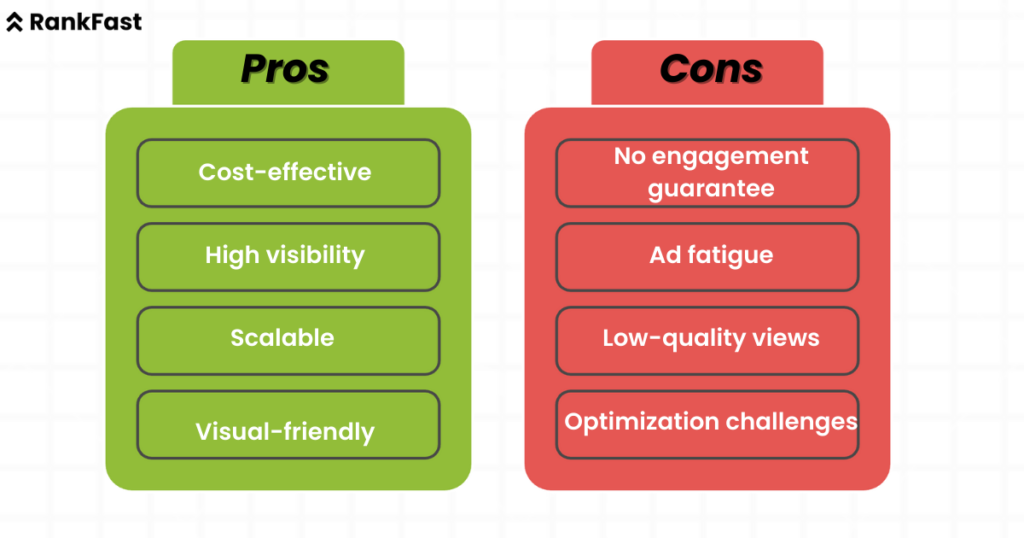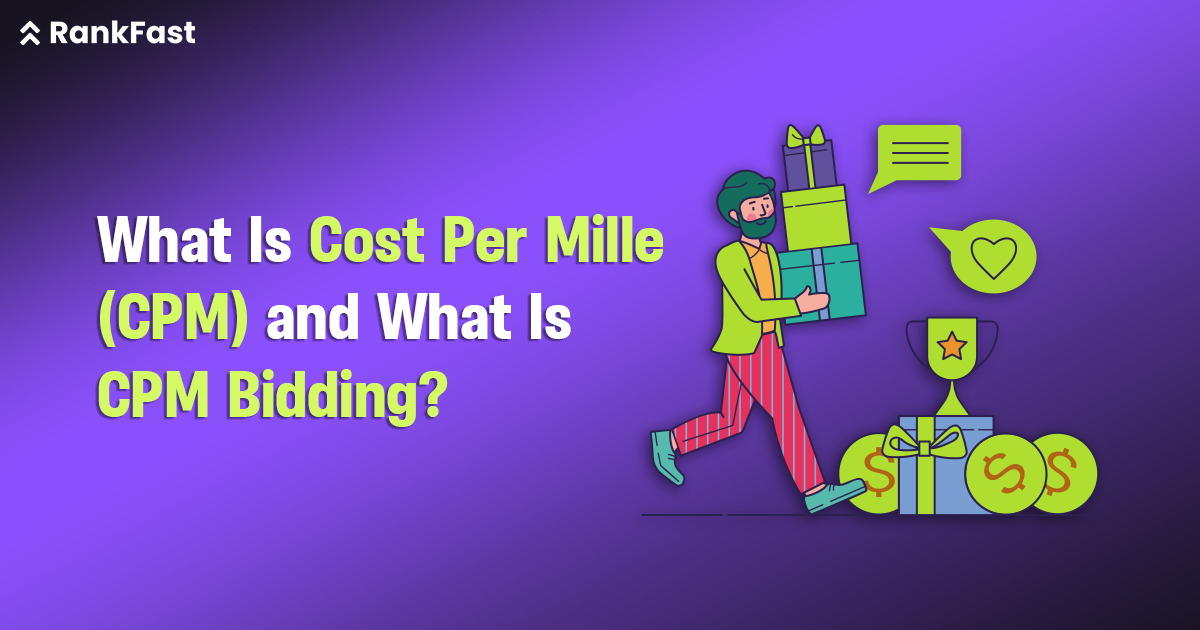Most campaigns fail because marketers use the wrong bidding model. Others are unaware of what they’re paying for. CPM sounds simple, but it’s often misunderstood.
One wrong assumption and you lose money without results. In this blog, we break down what Cost Per Mille is, how it works, and when to use it for better results.
What Does CPM Mean in Advertising?
Cost Per Mille (CPM) refers to the price you pay to display your ad one thousand times. That’s all it means. The “Mille” is Latin for thousand. You don’t pay for clicks. You don’t pay for conversions. You pay for views, or more precisely, impressions.
This model is great when your goal is visibility. Not everyone wants traffic right away. Some brands just want to be seen. Awareness ads, display banners, and YouTube pre-rolls often use CPM.
According to Shopify, ad costs can vary a lot. For example, on Facebook:
- CPC (Cost Per Click): around $0.70
- CPM (Cost Per Mille): about $12.74
- CPL (Cost Per Lead): around $32.69
So, CPM is the cheapest if you want to reach. However, you must track whether those views yield long-term results. Many marketers focus solely on reach, rather than engagement. That’s the trap.
Now let’s break down what Cost Per Mille mathematically and practically.
How Is CPM Calculated?
The formula for Cost Per Mille is simple:
CPM = (Total Cost ÷ Total Impressions) × 1,000
Let’s say you spent $500 on an ad that got 100,000 views.
CPM = ($500 ÷ 100,000) × 1,000 = $5
So, you paid $5 for every 1,000 impressions.
Now here’s what most marketers miss:
Even if you have a low Cost Per Mille, that doesn’t mean the campaign worked. If no one clicks or remembers your ad, it’s wasted money.
That’s why CPM works best when:
- Your creative is strong and memorable
- Your goal is to reach a large, cold audience
- You want to test new markets or products
Use CPM carefully. Without tracking, you may only measure vanity.
Now that you know what Cost Per Mille is, let’s understand how bidding for it works.
What Is CPM Bidding?
Now, to the next part, what is CPM bidding?
CPM bidding is the method advertisers use to tell ad platforms they’re willing to pay a certain amount per thousand impressions. This is not the same as CPC bidding, where you pay only when users click. With CPM bidding, you’re paying just to be seen.
You place a bid, let’s say $8 CPM. The ad platform checks all bids and picks which ad that gets the slot. This auction happens in real time, every time an ad loads.
So, what is a CPM bid? It’s your offer to the platform: “I’ll pay this much to show my ad to 1,000 users.” But if someone else bids more, you lose that slot. If your ad performs better (better engagement), you can still win, even with a lower bid.
You might be thinking, why bid on impressions instead of clicks? Here’s when it makes sense:
- You’re promoting a brand video
- You’re running an awareness campaign
- You have strong creativity that drives direct action
- You want to retarget audiences that didn’t engage before
The answer to what is CPM bidding also depends on how well you match your bid to the campaign objective. Don’t set high bids if your ad creative is weak. You’ll burn the budget fast.
Let’s now see how this compares with other bidding types.
CPM vs CPC vs CPA: What’s the Difference?
Marketers often confuse bidding models. Each has its role. Let’s break it down.
CPC (Cost Per Click): You pay only when someone clicks on your ad. Great for traffic-focused campaigns.
CPA (Cost Per Acquisition): You pay only when a goal is met, like a sign-up or sale. This is best for direct-response ads.
CPM (Cost Per Mille): You pay to show your ad. Great for brand awareness and visual storytelling.
| Model | You Pay For | Best For | Risk Level | Example Use Case |
| CPM | 1,000 impressions | Brand awareness | Medium | Display ads, YouTube intro videos |
| CPC | Each click | Traffic | Low | Google Search ads |
| CPA | Final action | Conversions | High | Lead-gen, checkout pages |
If your goal is to introduce a new product, use Cost Per Mille. If you’re chasing leads, CPA is better. For blogs or landing pages, CPC often works well.
Knowing when to switch helps avoid budget loss.
When Should You Use CPM Bidding?
So, when does CPM bidding make sense? Start with your goal.
1. Brand Awareness Campaigns
If your goal is to reach as many people as possible, use CPM. This is common in retail, fashion, entertainment, and FMCG ads.
2. High-Quality Creative Assets
When you have a strong video, visual, or story that doesn’t need a click to make an impact, CPM is perfect.
3. Launches and Product Reveals
Big launches need buzz. CPM helps you get seen quickly without relying on user action.
4. Retargeting Top-Funnel Audiences
You can re-engage cold leads just by showing your ad again. CPM keeps the cost low and the visibility high.
5. Influencer and Event Promotions
If you’re tying ads to events, concerts, or influencer rollouts, you want to reach fast. CPM bidding suits this urgency.
Still, you must check viewability and frequency. Showing the same ad too many times can waste budget and annoy users.
Pros and Cons of CPM Bidding
Using CPM bidding the right way gives you reach. But the wrong use drains money. Let’s break it down.

Pros:
- Cheaper entry point for a large reach
- Good for brand visibility and recall
- Easier to scale across regions
- Works well with video and visuals
- Simple to measure impressions
Cons:
- No guarantee of clicks or conversions
- Ad fatigue if frequency is too high
- Low-quality views if targeting is broad
- Difficult to optimize without strong creative
- Not suited for ROI-heavy campaigns
So, the answer to what a CPM bid is also includes knowing when not to use it. CPM isn’t ideal for early-stage startups looking for leads. It works for known brands with a clear story to tell.
How to Optimize Your CPM Campaigns
Now let’s talk about performance. Here are ways to make CPM bidding work better.
1. Tighten Audience Targeting
The more specific your audience, the better the ad performs. Avoid wide settings. Focus on behavior, location, device, or interest.
2. Use Frequency Caps
Control how often your ad shows to the same user. Set daily or weekly limits.
3. A/B Test Creative
Run 2–3 versions of your ad. Test visuals, copy, and placement. Compare view times, clicks, and engagement.
4. Track Viewability
Use metrics like Viewable CPM. If users skip your ad in 1 second, it still counts as an impression. Avoid that loss.
5. Use Short Video Formats
6-second or 15-second ads hold better attention in CPM models. People don’t skip what ends fast.
6. Retarget Based on Engagement
Retarget those who viewed at least 50% of your ad. These are warm leads. Use stronger CTAs next.
Best Platforms for CPM Advertising
Some platforms work better with Cost Per Mille strategies. Choose based on your campaign needs.
- Facebook Ads: Great for video, carousel, and story ads
- YouTube (via Google Ads): Perfect for reach and brand recall
- Instagram: High visual impact for fashion, travel, food
- LinkedIn: Works well for B2B branding
- Programmatic Platforms: For display and retargeting across networks
Each supports CPM bidding with controls for placement and audience filters. Test small before scaling.
Common Mistakes to Avoid with CPM Bidding
1. Using Weak Creatives
Low-quality visuals kill CPM campaigns. People skip boring ads. Make your visuals clean, sharp, and message-focused.
2. Targeting Everyone
Broad reach sounds good, but it lowers quality. Always define your audience tightly.
3. Not Monitoring Frequency
Don’t let the same ad run 20 times to one person. That wastes money and irritates users.
4. Skipping A/B Testing
If you never test creatives, you can’t learn what works. Always rotate 2–3 versions.
5. Ignoring Viewability Metrics
Just because your ad loaded doesn’t mean someone saw it. Use VCPM or engagement data.
Learning what is CPM bidding also means learning when to pause and fix.
Final Thoughts
Still spending and not seeing results? You may be bidding wrong. CPM is useful, but only when paired with the right creative and targeting. If you’re guessing instead of planning, it’s time to rethink.
At Rankfast, we help brands run smarter CPM campaigns with real returns. Want better reach without wasting budget? Let’s plan it right together.
FAQs
1. What is Cost Per Mille in advertising?
Cost Per Mille means paying for every 1,000 times your ad appears, not clicks or actions.
2. What is a CPM bid, and how is it set?
A CPM bid is your offer to pay per thousand impressions. You set this in the ad platform during campaign setup.
3. What is CPM bidding best used for?
CPM bidding works best for branding, video views, product launches, and top-of-funnel awareness.
4. How do I calculate Cost Per Mille?
Use this formula: CPM = (Ad Spend ÷ Impressions) × 1,000. It tells you the cost per 1,000 views.
5. Can CPM campaigns drive conversions?
They can, but only when your creatives engage and your targeting is accurate. Otherwise, clicks may stay low.

Leave a Reply